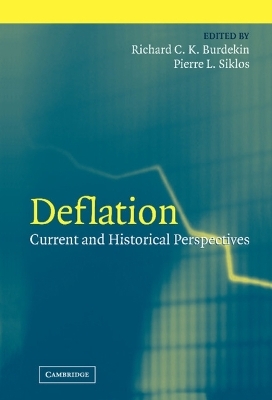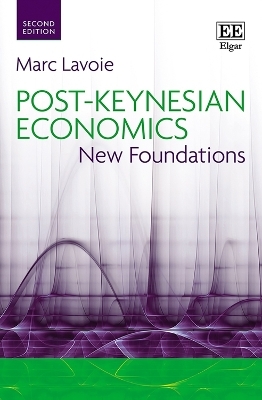
Deflation
Cambridge University Press (Verlag)
978-0-521-83799-6 (ISBN)
This book was originally published in 2004. Fears of deflation seemed nothing more than a relic of the Great Depression. However, beginning in the 1990s, persistently falling consumer prices have emerged in Japan, China and elsewhere. Deflation is also a distinct possibility in some of the major European area economies, especially Germany, and emerged as a concern of the US Federal Reserve in 2003. Deflation may be worse than inflation not only because the real burden of debt rises but also because firms would confront rising real wages in a world where nominal wage rigidity prevails. This volume explores some key themes regarding deflation including: (i) how economic agents and policy makers have responded to deflation, (ii) the links between monetary policy, goods price movements, and asset price movements, (iii) the impact of deflation under different monetary policy and exchange rate regimes, and (iv) stock market reactions to deflation.
Richard C. K. Burdekin is Jonathan B. Lovelace Professor of Economics at Claremont McKenna College, Claremont, California. His areas of interest include monetary and financial economics, Chinese economics reforms, and inflation and deflation. Professor Burdekin has published four books: Budget Deficits and Economic Performance (with Farrokh K. Langdana), Confidence, Credibility and Macroeconomic Policy (with Farrokh K. Langdana), Distributional Conflict and Inflation (with Paul Burkett), and Establishing Monetary Stability in Emerging Market Economies (edited with Thomas D. Willett, Richard J. Sweeney, and Clas Wihlborg). He has also authored over forty refereed journal articles which have been published in the American Economic Review, the Journal of Economic History, the Journal of International Money and Finance, the Journal of Money, Credit and Banking, and the Review of Economics and Statistics, among other leading publications. Pierre L. Siklos is Professor of Economics at Wilfrid Laurier University, Waterloo, Ontario, Canada, and Associate Director of its Viessmann Centre for the Study of Modern Europe. He specializes in macroeconomics with an emphasis on the study of inflation, central banks, and financial markets and also conducts research in applied time series analysis. Professor Siklos has been a consultant to a variety of institutions and central banks. He is the author of several books, including the leading textbook in Canada on money and banking, and The Changing Face of Central Banking: Evolutionary Trends Since World War II (Cambridge University Press, 2002). He has also published numerous articles in eminent economics journals. Professor Siklos has been a visiting lecturer or fellow at several universities in Europe, North America and New Zealand.
List of tables and figures; List of contributors; Preface; 1. Fears of deflation and the role of monetary policy: some lessons and an overview Richard C. K. Burdekin and Pierre L. Siklos; Part I. Fears of Deflation and the Role of Monetary Policy: 2. Deflation, silent runs, and bank holidays in the great contraction Hugh Rockhoff; 3. Price change, financial stability, and the British economy, 1870–1939 Forrest Capie and Geoffrey Wood; 4. Deflation dynamics in Sweden: perceptions, expectations, and adjustment during the deflations of 1921–1923 and 1931–1933 Klas Fregert and Lars Jonung; Part II. Deflation and Asset Prices: 5. Boom-busts in asset prices, economic instability, and monetary policy Michael D. Bordo and Olivier Jeanne; 6. Deflation, credit and asset prices Charles Goodhart and Boris Hofmann; Part III. International Perspectives on Deflation: 7. Is deflation depressing? Evidence from the classical gold standard Michael D. Bordo and Angela Redish; 8. The strong Lira policy and deflation in Italy's interwar period Michele Fratianni and Franco Spinelli; 9. Deflation and stagnation in Japan: collapse of the monetary transmission mechanism and echo from the 1930s Michael M. Hutchison; Part IV. Stock Market Adjustment to Deflation: 10. Deflation, the financial crises of the 1890s, and Stock Exchange responses in London, New York, Paris, and Berlin Lance Davis, Larry Neal, and Eugene White; 11. The Stock Market and the business cycle in periods of deflation, (hyper-)inflation, and political turmoil: Germany 1913–1926 Martin T. Bohl and Pierre L. Siklos; 12. Deflationary pressures and the role of gold stocks: 1929, 1987 and today Richard C. K. Burdekin and Marc D. Weidenmier; References; Index.
| Erscheint lt. Verlag | 6.9.2004 |
|---|---|
| Reihe/Serie | Studies in Macroeconomic History |
| Verlagsort | Cambridge |
| Sprache | englisch |
| Maße | 161 x 236 mm |
| Gewicht | 638 g |
| Themenwelt | Wirtschaft ► Volkswirtschaftslehre ► Finanzwissenschaft |
| ISBN-10 | 0-521-83799-5 / 0521837995 |
| ISBN-13 | 978-0-521-83799-6 / 9780521837996 |
| Zustand | Neuware |
| Haben Sie eine Frage zum Produkt? |
aus dem Bereich


